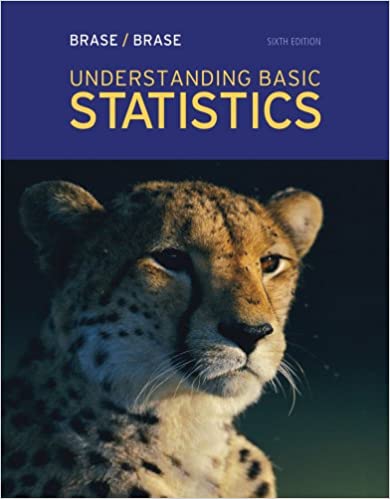
Understanding Basic Statistics 6th Edition by Charles Henry Brase,Corrinne Pellillo Brase
Edition 6ISBN: 978-1111827021
Understanding Basic Statistics 6th Edition by Charles Henry Brase,Corrinne Pellillo Brase
Edition 6ISBN: 978-1111827021 Exercise 50
Focus Problem: Wood-Duck Nests In the Focus Problem at the beginning of this chapter, a study was described comparing the hatch ratios of wood-duck nesting boxes. Group I nesting boxes were well separated from each other and well hidden by available brush. There were a total of 474 eggs in group I boxes, of which a field count showed about 270 hatched. Group II nesting boxes were placed in highly visible locations and grouped closely together. There were a total of 805 eggs in group II boxes, of which a field count showed about 270 hatched.
(a) Find a point estimate
 for p 1 , the proportion of eggs that hatch in group I nesting boxes. Find a 95% confidence interval for p 1.
for p 1 , the proportion of eggs that hatch in group I nesting boxes. Find a 95% confidence interval for p 1.
(b) Find a point estimate
 for p 2 , the proportion of eggs that hatch in group II nesting boxes. Find a 95% confidence interval for p 2.
for p 2 , the proportion of eggs that hatch in group II nesting boxes. Find a 95% confidence interval for p 2.
(c) Find a 95% confidence interval for p 1 p 2. Does the interval indicate that the portion of eggs hatched from group I nesting boxes is higher than, lower than, or equal to the proportion of eggs hatched from group II nesting boxes
(d) Interpretation What conclusions about placement of nesting boxes can be drawn In the article discussed in the Focus Problem, additional concerns are raised about the higher cost of placing and maintaining group I nesting boxes. Also at issue is the cost efficiency per successful wood duck hatch.
(a) Find a point estimate
 for p 1 , the proportion of eggs that hatch in group I nesting boxes. Find a 95% confidence interval for p 1.
for p 1 , the proportion of eggs that hatch in group I nesting boxes. Find a 95% confidence interval for p 1.(b) Find a point estimate
 for p 2 , the proportion of eggs that hatch in group II nesting boxes. Find a 95% confidence interval for p 2.
for p 2 , the proportion of eggs that hatch in group II nesting boxes. Find a 95% confidence interval for p 2.(c) Find a 95% confidence interval for p 1 p 2. Does the interval indicate that the portion of eggs hatched from group I nesting boxes is higher than, lower than, or equal to the proportion of eggs hatched from group II nesting boxes
(d) Interpretation What conclusions about placement of nesting boxes can be drawn In the article discussed in the Focus Problem, additional concerns are raised about the higher cost of placing and maintaining group I nesting boxes. Also at issue is the cost efficiency per successful wood duck hatch.
Explanation
We are given that
=270,
=270,
=...
Understanding Basic Statistics 6th Edition by Charles Henry Brase,Corrinne Pellillo Brase
Why don’t you like this exercise?
Other Minimum 8 character and maximum 255 character
Character 255


